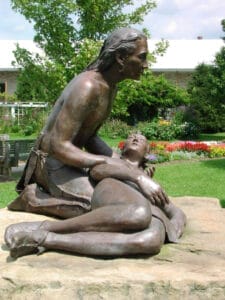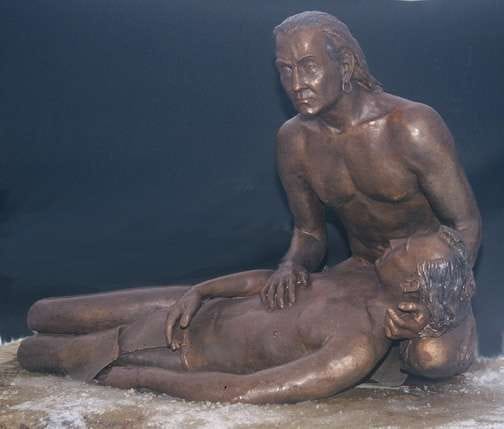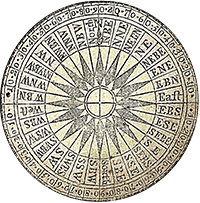Buckongahelas (Giver of Presents) was born in present-day Delaware around the year 1720 to Lenape parents. The British colonists called the people the Delaware, after the river, which was the heart of their territory. The Lenape (otherwise known as Delaware Tribe) lived primarily in Delaware, New Jersey, New York, and Pennsylvania.
As a young man, Buckongahelas started a family. Under pressure from colonial settlers, he began to move his family and band westward. He settled with his people in what is now Buckhannon in Upshur County, West Virginia.
His son Mahonegon was killed there in June 1773 by Captain William White, a native of Frederick County, Virginia. Local legend states that the current Upshur County Courthouse was built over Mahonegon’s grave. Nine years later, Captain White was killed by Indians. There are legends of White’s death being attributed Buckongahelas, but by that time, the Lenape had already relocated in Indiana.
During the American Revolutionary War, Buckongahelas led his followers against the Continentals. He broke away from the neutral and pro-American Delaware led by Chief White Eyes. He took his band west to establish a town near the war chief Blue Jacket of the Shawnee. The two leaders became close allies.
During the revolutionary war era, a number of Lenape who had converted to Christianity were living in frontier villages run by Moravian missionaries. In April 1781, Buckongahelas warned the Gnadenhutten Lenape that an American militia from Pennsylvania was likely to execute any Indians in their path and would not pay attention to their Christian pacifism. He urged the pacifists to follow him to safety -further west away from the Americans. The Christian Lenape refused to listen to Buckongahelas.
A Moravian missionary, who was present at the time, stated that eleven months after Buckongahelas warned the Gnadenhutten Lenape, ninety-six of these same Christian Indians, mostly women and children, were murdered at the place where Buckongahelas tried to warn them. On March 8, 1782, the militia attacked and killed the Lenape in what is known as the Gnadenhütten massacre.
In the Treaty of Paris (1783) that ended the Revolutionary War, the British ceded Indian lands in the Ohio Country that were not theirs to the United States. In the late 1780s, Buckongahelas joined a Shawnee-led confederacy to try to repel the American settlers who had begun migrating west of the Appalachian Mountains, using the Ohio River to penetrate the territory. With British support, they won several battles against the Americans in the Northwest Indian Wars.
Then, in 1791, Buckongahelas joined with the Miami and Shawnee, Little Turtle (Miami), Blue Jacket (Shawnee) at the Battle of the Wabash. This 4 hour battle was the most devastating military victory ever achieved by Native Americans in the United States. Of the 1,400 regulars, levies, and militia led by General Arthur St. Clair, 918 were killed and 276 wounded.
The Indian confederacy was finally defeated at the Battle of Fallen Timbers in 1794. The British failed to support the Indian confederacy after this battle, and Buckongahelas signed the Treaty of Greenville on August 3, 1795. In this treaty, the Delaware ceded much land in Pennsylvania and Ohio to the United States. At times, competing tribes tried to control the lands and villages, and it was not clear that the chiefs who signed the treaties had authority over the lands they were ceding.

Buckongahelas spent his final years living with his people on the White River near present-day Muncie, Indiana. He died in May 1805 at the age of 85. Chief Buckongahelas’ loss of his son Mahonegon was later memorialized in a bronze statue that was placed in Jawbone Run Park, Buckhannon WV. The statue was created by Ross Straight. The statue depicts the chief cradling the body of his son.
(Ross Straight raised over $20K to create this statue and did not profit from this work. His website is https://myplace.frontier.com/~straights/index.html )
Sources:
Armyhistory.org
Myplace.frontier.com
Wikipedia
Wikitree
Welcome to “Sharing the Stories of History with Tim Mann”!
Meet Timothy A. Mann, a passionate historian born and raised in the heart of Shelby County, Ohio where Tim’s roots run deep in the rich soil of American history. As the author of articles and books, including “Frontier Miscellany Concerning the Miami County Ohio Militia,” “Colonel John Mann, His Kith and Kin,” and “Frontier Militia – The War of 1812,” Tim’s literary contributions have enlightened and inspired countless history enthusiasts.
Join Tim Mann on a journey through time as he shares fascinating tales, untold stories, and hidden gems from the annals of history. Let’s delve into the past together and uncover the wonders that await in “Sharing the Stories of History with Tim Mann.”




